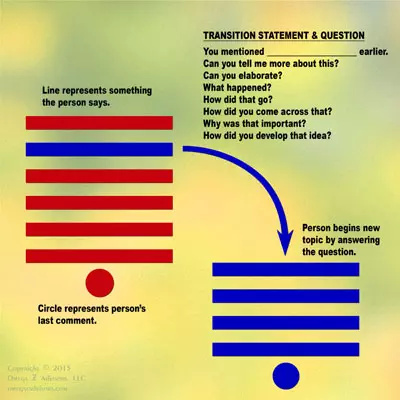Be a Better Conversationalist Overnight with Refer-Back Tip
This is a sequel to my previous post. That tip was about asking questions. This tip is called Refer Back. It too helps us become a better conversationalist overnight.
As with questions, the Refer Back Tip (RBT), shows we are listening. It is one thing to listen. It is another to show we are. RBT helps with that.
Advancements in artificial intelligence have shown another value in this tip. It is hard to include it in the conversational program of computers. Our use of it then adds a more human, dynamic quality to our conversations.
Refer-Back Tip

The Refer Back Tip makes us better conversationalists by making conversations better.
RBT has two parts:
- A transition statement referencing an earlier comment
- A question about that comment
The figure to the right helps us see how this works. It gives a sample transition statement. It follows this with seven sample questions.
The keys to using this tip are:
- Listening for opportunities to refer back
- Asking the right question to make the transition seamless
Here are some other examples.
- I found your comment earlier about ____________ fascinating. What other insights can you share on that?
- I’d like to go back to something you said before about ____________. How would you apply that in a situation where____________?
- I thought what you said earlier about ____________ was important. What other reasons can you give?
This tip is also very useful with endless talkers. It helps us refocus them on the topics we want. In this way, their comments become the menu from which we select what we want to hear.
Why This Makes Us a Better Conversationalist
The main reason why RBT makes us a better conversationalist is that we make conversations better. It not only shows we listen. It shows we add a unique aspect to the conversation.
It is this. Research on how conversations flow shows that they go with the most recent comment. If I mention cars and then someone mentions houses, the third person will likely talk about houses.
It is so predictable. This is a major way we program computers to continue conversations. They focus on the last thing we said.
RBT adds spice to conversations. It breaks up their mundane, predictable flow. We make conversations better. That makes us better conversationalists.
Related post:
How to Become a Good (or Better) Conversationalist Overnight


Yhat kind of restating accomplishes SO much good in conversation, reinforcing the discussion overall and refocusing the discussion as you discuss. From an NLP perspective, it is beneficial to also use the same choice of words that they used — matching.
And once they have restated, it is sure beneficial to lead them into a next framework if you are in a persuading mode.
You said that, “Listening builds relationships, but it helps if the other person realizes you are doing it.”
Can you elaborate on any other benefits of demonstrating that you are interested in what they have to say as it relates to what you would like to discuss and how it might relate to intrinsic motivation and teamwork?
(grin)
.
Thank you for asking, Scott. This link http://blog.omegazadvisors.com/series/relationship-building-technique/ provides eight other relationship building techniques similar – but more detailed – than this one. One is even the technique you reference.
Other benefits include relationship building and influencing. Keep in mind that one of the most power motivations is doing something simply because someone asked us to do so. For example, in getting out the vote campaigns, research shows that simply asking someone to vote is the most persuasive way to get someone to vote. As for teamwork, keep in mind that in a military unit, when everything else is gone, the force that keeps it together is mutual dependency. If a soldier does not do his job, it could cause the death of the comrade to the left or right of him. We can tap this same influence in a business setting. It helps to have a mutual appreciating for how our work helps others’ work.
I solved some tardiness problems for a client simply by asking people to show up on time for me. (I was a fill-in HR Manager at the time.) Of course, how you ask is very important and needs to be tailored to the situation. I was basically leveraging the relationship I had built with the employees.
Funny on that last comment about showing up on time…
MANY years ago, I had a client with a similar culture, where meetings would never ever start on time and execs would send there secretaries over to the meeting room to see if anyone was there yet.
I did the same thing, asking for people to respect the time of others and the business and to show up for MY meetings in a timely way. That went well until the CEO decided not to even show for a meeting scheduled at 5 PM the night before between me, his CFO and my HR friend. If HE was not going to be on time (and he was not in general), then what would change.
20+ years later, he is still pissed at me for firing him as a client. The HR woman and I are still great pals, so I know that as a fact. He did not stay much longer in the company, either, choosing to leave to find other avenues for his time…
.